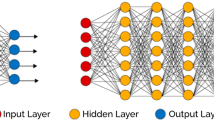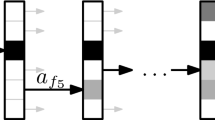Abstract
Data in real-world application often exhibit skewed class distribution which poses an intense challenge for machine learning. Conventional classification algorithms are not effective in case of imbalanced data distribution, and may fail when the data distribution is highly imbalanced. To address this issue, we propose a general imbalanced classification model based on deep reinforcement learning, in which we formulate the classification problem as a sequential decision-making process and solve it by a deep Q-learning network. In our model, the agent performs a classification action on one sample in each time step, and the environment evaluates the classification action and returns a reward to the agent. The reward from the minority class sample is larger, so the agent is more sensitive to the minority class. The agent finally finds an optimal classification policy in imbalanced data under the guidance of the specific reward function and beneficial simulated environment. Experiments have shown that our proposed model outperforms other imbalanced classification algorithms, and identifies more minority samples with better classification performance.




Similar content being viewed by others
Notes
Retrievethedatasetsfromhttps://keras.io/datasets
References
Japkowicz N, Stephen S (2002) The class imbalance problem: a systematic study. Intell Data Anal 6 (5):429–449
Weiss GM (2004) Mining with rarity: a unifying framework. ACM Sigkdd Explorations Newsletter 6(1):7–19
He H, Garcia EA (2008) Learning from imbalanced data. IEEE Trans Knowl Data Eng 9:1263–1284
Haixiang G, Yijing L, Shang J, Mingyun G, Yuanyue H, Bing G (2017) Learning from class-imbalanced data: Review of methods and applications. Expert Syst Appl 73:220–239
Mnih V, Kavukcuoglu K, Silver D, Graves A, Antonoglou I, Wierstra D, Riedmiller M (2013) Playing atari with deep reinforcement learning. arXiv:1312.5602
Gu S, Holly E, Lillicrap T, Levine S (2017) Deep reinforcement learning for robotic manipulation with asynchronous off-policy updates. In: 2017 IEEE International Conference on Robotics and Automation (ICRA), IEEE, pp 3389–3396
Zhao X, Zhang L, Ding Z, Yin D, Zhao Y, Tang J (2017) Deep reinforcement learning for list-wise recommendations. arXiv:1801.00209
Feng J, Huang M, Zhao L, Yang Y, Zhu X (2018) Reinforcement learning for relation classification from noisy data. In: Proceedings of AAAI
Martinez C, Perrin G, Ramasso E, Rombaut M (2018) A deep reinforcement learning approach for early classification of time series. In: EUSIPCO, 2018
Drummond C, Holte RC, et al. (2003) C4. 5, class imbalance, and cost sensitivity: why under-sampling beats over-sampling. In: Workshop on Learning from Imbalanced datasets II, vol 11, Citeseer, pp 1–8
Han H, Wang W-Y, Mao B-H (2005) Borderline-smote: a new over-sampling method in imbalanced data sets learning. In: International Conference on Intelligent Computing, Springer, pp 878–887
Mani I (2003) I Zhang, knn approach to unbalanced data distributions: a case study involving information extraction. In: Proceedings of Workshop on Learning from Imbalanced Datasets, vol 126
Batista GE, Prati RC, Monard MC (2004) A study of the behavior of several methods for balancing machine learning training data. ACM SIGKDD Explorations Newsletter 6(1):20–29
Akkasi A, Varoğlu E, Dimililer N (2017) Balanced undersampling: a novel sentence-based undersampling method to improve recognition of named entities in chemical and biomedical text. Appl Intell, pp 1–14
Gupta D, Richhariya B (2018) Entropy based fuzzy least squares twin support vector machine for class imbalance learning. Appl Intell 48(11):4212–4231
Wu G, Chang EY (2005) Kba: Kernel boundary alignment considering imbalanced data distribution. IEEE Trans Knowl Data Eng 17(6):786–795
Tang Y, Zhang Y-Q, Chawla NV, Krasser S (2009) Svms modeling for highly imbalanced classification. IEEE Transactions on Systems, Man, and Cybernetics, Part B (Cybernetics) 39(1):281–288
Su C, Cao J (2018) Improving lazy decision tree for imbalanced classification by using skew-insensitive criteria. Applied Intelligence
Zadrozny B, Elkan C (2001) Learning and making decisions when costs and probabilities are both unknown. In: Proceedings of the seventh ACM SIGKDD International Conference on Knowledge Discovery and Data Mining, ACM, pp 204–213
Zadrozny B, Langford J, Abe N (2003) Cost-sensitive learning by cost-proportionate example weighting. In: ICDM, 2003, Third IEEE International Conference on Data Mining, 2003, IEEE, pp 435–442
Zhou Z-H, Liu X-Y (2006) Training cost-sensitive neural networks with methods addressing the class imbalance problem. IEEE Trans Knowl Data Eng 18(1):63–77
Krawczyk B, Woźniak M (2015) Cost-sensitive neural network with roc-based moving threshold for imbalanced classification. In: International Conference on Intelligent Data Engineering and Automated Learning, Springer, pp 45–52
Chen J, Tsai C-A, Moon H, Ahn H, Young J, Chen C-H (2006) Decision threshold adjustment in class prediction. SAR QSAR Environ Res 17(3):337–352
Yu H, Sun C, Yang X, Yang W, Shen J, Qi Y (2016) Odoc-elm: Optimal decision outputs compensation-based extreme learning machine for classifying imbalanced data. Knowl-Based Syst 92:55–70
Ting KM (2000) A comparative study of cost-sensitive boosting algorithms. In: Proceedings of the 17th International Conference on Machine Learning Citeseer
Janisch J, Pevnỳ T, Lisỳ V (2017) Classification with costly features using deep reinforcement learning. arXiv:1711.07364
Wang S, Liu W, Wu J, Cao L, Meng Q, Kennedy PJ (2016) Training deep neural networks on imbalanced data sets, in Neural Networks (IJCNN). In: 2016 International Joint Conference on. IEEE, pp 4368–4374
Huang C, Li Y, Change Loy C, Tang X (2016) Learning deep representation for imbalanced classification. In: Proceedings of the IEEE Conference on Computer Vision and Pattern Recognition, pp 5375–5384
Yan Y, Chen M, Shyu M-L, Chen S-C (2015) Deep learning for imbalanced multimedia data classification. In: Multimedia (ISM). In: 2015 IEEE International Symposium on. IEEE, pp 483– 488
Khan SH, Hayat M, Bennamoun M, Sohel FA, Togneri R (2018) Cost-sensitive learning of deep feature representations from imbalanced data. IEEE Trans Neural Netw Learn Syst 29(8):3573–3587
Dong Q, Gong S, Zhu X (2018) Imbalanced deep learning by minority class incremental rectification. IEEE Transactions on Pattern Analysis and Machine Intelligence
Wiering MA, van Hasselt H, Pietersma A-D, Schomaker L (2011) Reinforcement learning algorithms for solving classification problems. In: 2011 IEEE Symposium on Adaptive Dynamic Programming And Reinforcement Learning (ADPRL), IEEE, pp 91–96
Zhang T, Huang M, Zhao L (2018) Learning structured representation for text classification via reinforcement learning. AAAI
Liu D, Jiang T (2018) Deep reinforcement learning for surgical gesture segmentation and classification. arXiv:1806.08089
Zhao D, Chen Y, Lv L (2017) Deep reinforcement learning with visual attention for vehicle classification. IEEE Trans Cogn Develop Syst 9(4):356–367
Abdi L, Hashemi S (2014) An ensemble pruning approach based on reinforcement learning in presence of multi-class imbalanced data. In: Proceedings of the Third International Conference on Soft Computing for Problem Solving, Springer, pp 589–600
Dixit AK, Sherrerd JJ, et al. (1990) Optimization in economic theory. Oxford University Press on Demand
Lin T-Y, Goyal P, Girshick R, He K, Dollár P (2017) Focal loss for dense object detection. In: Proceedings of the IEEE International Conference on Computer Vision, pp 2980–2988
Gu Q, Zhu L, Cai Z (2009) Evaluation measures of the classification performance of imbalanced data sets. In: International Symposium on Intelligence Computation and Applications, Springer, pp 461–471
Bengio Y (2012) Practical recommendations for gradient-based training of deep architectures. In: Neural Networks: Tricks of the Trade, Springer, pp 437–478
Demšar J (2006) Statistical comparisons of classifiers over multiple data sets. J Mach Learn Res 7(Jan):1–30
Benavoli A, Corani G, Mangili F (2016) Should we really use post-hoc tests based on mean-ranks? J Mach Learn Res 17(1):152–161
Wilcoxon F (1992) Individual comparisons by ranking methods. In: Breakthroughs in Statistics, Springer, pp 196–202
Holm S (1979) A simple sequentially rejective multiple test procedure. Scandinavian journal of statistics, pp 65–70
Author information
Authors and Affiliations
Corresponding author
Additional information
Publisher’s note
Springer Nature remains neutral with regard to jurisdictional claims in published maps and institutional affiliations.
Rights and permissions
About this article
Cite this article
Lin, E., Chen, Q. & Qi, X. Deep reinforcement learning for imbalanced classification. Appl Intell 50, 2488–2502 (2020). https://doi.org/10.1007/s10489-020-01637-z
Published:
Issue Date:
DOI: https://doi.org/10.1007/s10489-020-01637-z




